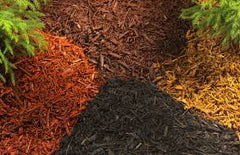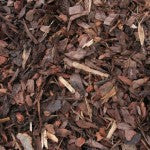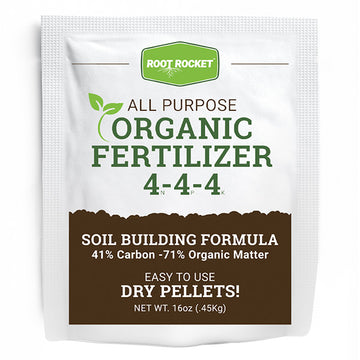The Use of Mulch
Mulch is one of the simplest ways to enhance your garden and plants. It can make your plantings healthy by providing many benefits to the soil as well as improving the overall appearance of your landscaping. In the long run, mulch will greatly reduce the amount of time in which you maintain your landscapes and gardens. Mulched gardens are healthier, weed-free, and drought resistant. When you leave your garden un-mulched, you will be spending more time watering, weeding, and fighting pest and disease problems. This guide will show you how to correctly install Mulch in your landscape.
Why Mulch?
Mulch is beneficial in many different ways. Is suppresses weeds from popping up, therefore reducing the amount of time you spend in the garden picking them! Even if these sneaky little weeds do pop through, mulch makes them a lot easier to remove. Mulch also lessens the amount of watering. It acts as a barrier that prevents the process of evaporation from occurring. Less evaporation means less water is being taken from the soil and root systems. Temperature can also be regulated. Mulch acts as an insulator in periods of extreme cold and heat, which in turn protects your plants root systems from being damaged. Another benefit would be the reduction of soil compaction and erosion. When the soil is loose, it yields happy and healthy plants. However, loose soil can trigger erosion to occur. The weight of mulch on top of the soil will prevent it from running away during periods of heavy rain. Not only does mulch provide a happy and healthy home for your plants, but it also gives your home and landscaping a polished clean look.
Start with Edging your Beds
After deciding which mulch you will use, the next thing is to prep your beds for the mulch. To get a nice sharp look, you will need to edge the bed first. Edging the bed can be done two ways. The first way is edging the bed by hand. Simply get a spade that is flat on the bottom and cut a vertical edge removing the soil. This will take time. Try to get it down 4 inches and gradually go up into the bed. This way its smooth and the bed is raised.

The other way is much easier. You will need to rent a bed edger from your local equipment rental company. This machine is a huge labor saver when edging your beds for mulch. Simply start at one end of the bed and pull the machine around your beds. Take your time because the machine has to do the work. It will cut a nice sharp edge around your beds with little effort. Make sure that you always call in your utility locates before doing any edging. Cable and phone lines are usually buried about 2 inches so you will probably cut them if not located.
Mulch Installation
Mulch should be applied in the fall or spring. In the spring, it is best to wait until mid-spring to apply mulch in planting beds and around root zones of plants after the soil has warmed up. Newly installed plants will benefit from mulch, especially in the fall, as it protects the roots from the cold winter weather. Mulch does not have to applied every year. New mulch should only be added as needed to avoid over mulching. As mulch ages, it can be plowed into the soil to promote additional decomposition and nutrients.
Trees and shrubs should have a layer of about 2”-3” around the base and no more. This ensures that soil compaction and root suffocation is avoided. Over mulching around the bases of trunks and stems can also promote the growth of pathogens and unwanted insects/pests. Perennials should have a layer of 2”-3” around the base of the established plants. Do not pile mulch around the crown and avoid heavy mounding around stems.
Start by loading up the wheelbarrow with mulch. Use a large aluminum shovel to fill the wheelbarrow up quickly. As you move the mulch to the landscape bed, dump small piles in the bed so that you can begin to spread the mulch. The smaller the piles, the easier it is to spread the mulch.
When you're finished, clean up any mulch on top of shrub branches or on hard surfaces with a leaf blower. That's it!
Different Types of Mulch
Organic mulch - Organic mulch is a bi-product of other industries that decomposes readily into the soil over time. Organic mulch provides an array of benefits for the planting beds. It conserves moisture by delaying the evaporation process. This in turn, allows the soil to stay moist for longer periods of time permitting the roots to absorb the water that is beneficial to their survival. It also minimizes erosion, inhibits weeds, and reduces soil borne pathogens. Soil temperature is moderated due to the extra insulation which protects the plants from extreme spells of heat or cold. Organic mulch also decomposes over time, which improves the quality of the soil by encouraging microorganisms. Not only is it beneficial to all plants and the soil, but it also reduces mowing around trees/plants and decreases mechanical injuries.  Hardwood bark – Hardwood bark is a by-product of lumber and paper industries. It comes in a variety of sizes from chipped to shredded and can be kept natural or dyed. This type of mulch is generally used around trees, shrubs, and perennials. This is probably the most widely used types of mulch in the market. They dyed mulch colors have become very popular over the last 10 years.
Hardwood bark – Hardwood bark is a by-product of lumber and paper industries. It comes in a variety of sizes from chipped to shredded and can be kept natural or dyed. This type of mulch is generally used around trees, shrubs, and perennials. This is probably the most widely used types of mulch in the market. They dyed mulch colors have become very popular over the last 10 years.  Softwood bark – Softwood bark is a by-product of the lumber and paper industries. Pine bark is the most common and it is mostly used under large trees and shrubs. Pine bark is acidic and decomposes at a slower rate, therefore it does not need to be replaced as often. Pine bark mulch is great for pansy flowers because they like the acidic soil.
Softwood bark – Softwood bark is a by-product of the lumber and paper industries. Pine bark is the most common and it is mostly used under large trees and shrubs. Pine bark is acidic and decomposes at a slower rate, therefore it does not need to be replaced as often. Pine bark mulch is great for pansy flowers because they like the acidic soil. Municipal tree waste - Municipal tree waste is made up of chunks of wood. It utilizes larger amounts of nitrogen in the soil as it decomposes and is useful for creating pathways. This type of mulch is usually found free or companies giving it away. It is in the form or wood chips.
Cocoa bean mulch – Cocoa bean mulch is a byproduct from chocolate industries. The hulls are naturally lightweight, are appropriate for all planting areas, and smell great! This mulch should be applied no more than one inch deep and lightly watered to prevent it from running away. They decompose quickly and require annuals applications. If you have pets that are frequently in the areas where you apply mulch, consider using a different material because chocolate can be lethal to animals when ingested.
Leaf Mulch - Leaf mulch can be created at home by creating a compost of shredded leaves. It can be used in all beds.
Grass Clippings - Grass clippings can be spread into a thin layer across vegetable and perennial beds and can be tilled into the soil at the end of the growing season. Allow each layer to dry before adding additional layers due to matting issues. Do not use clippings from lawns that have been treated with chemicals or that have turned to seed.
Composted animal manure - Composted animal manure can be used as a mulch or soil alteration. It is an excellent choice for new plantings because it adds rich nutrients into the soil thus improving the quality. Fresh manure should not be used because it can burn and damage the plants. Dot, cat, or pig manure should never be used in a vegetable garden.
Newspaper - Layers of black and white newspaper can be used to suppress weeds. Apply 2-3 layers at a time and cover with mulch. Newspaper will decompose over time and will be incorporated into the soil.
Inorganic Mulch
Inorganic mulch are used more to create a weed barrier. Mulch that act as rocks or gravel do not readily decompose, but are used as a decorative purpose. Inorganic mulch does not decompose quickly and therefore does not improve the quality of the soil.
Plastic film (polyethylene) – Plastic film is impermeable, meaning that water and nutrients cannot pass through. Plastic is best used along rows of vegetable gardens to warm the soil. It is not the best solution for long-term use. Sun exposure deteriorates the plastic and is only good to use for one season.
Landscape Fabric – Landscape fabric is a good choice for long-term use to suppress weeds because it allows water and nutrients to pass through. It can be used in conjunction with organic mulch and will decompose more quickly than most organic mulch.
Stone - Stone materials can be volcanic rock, crushed gravel, or marble chips. Stone does not retain moisture and it also absorbs and reflects heat. These are best used away from trees, shrubs and other plants.
Rubber - Rubber mulch is composed of recycled or ground tires. This product is still being researched and initial studies indicate possible toxicity levels as well as the risk of flammability. Rubber can remain in the soil indefinably and it not recommended to use in home landscapes.

